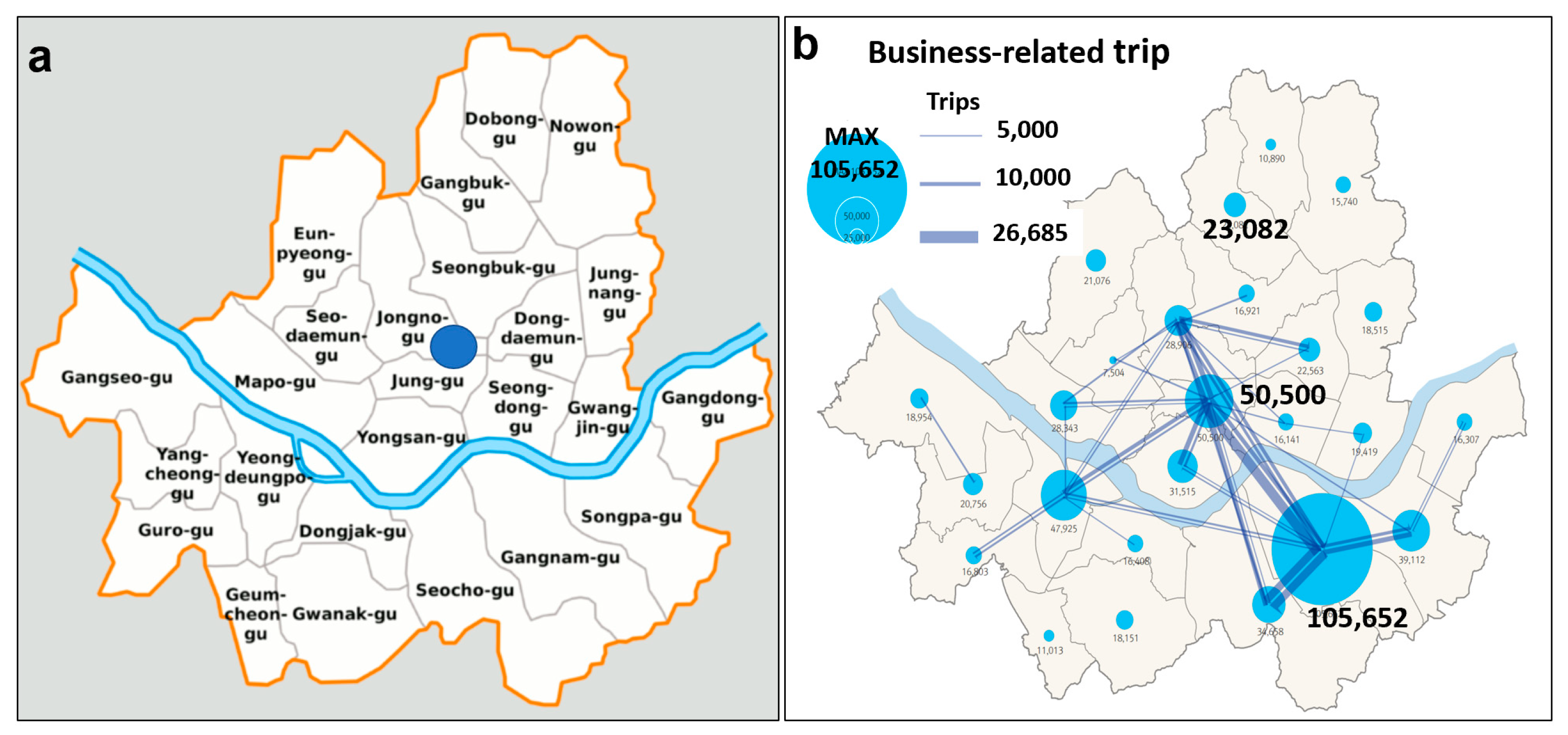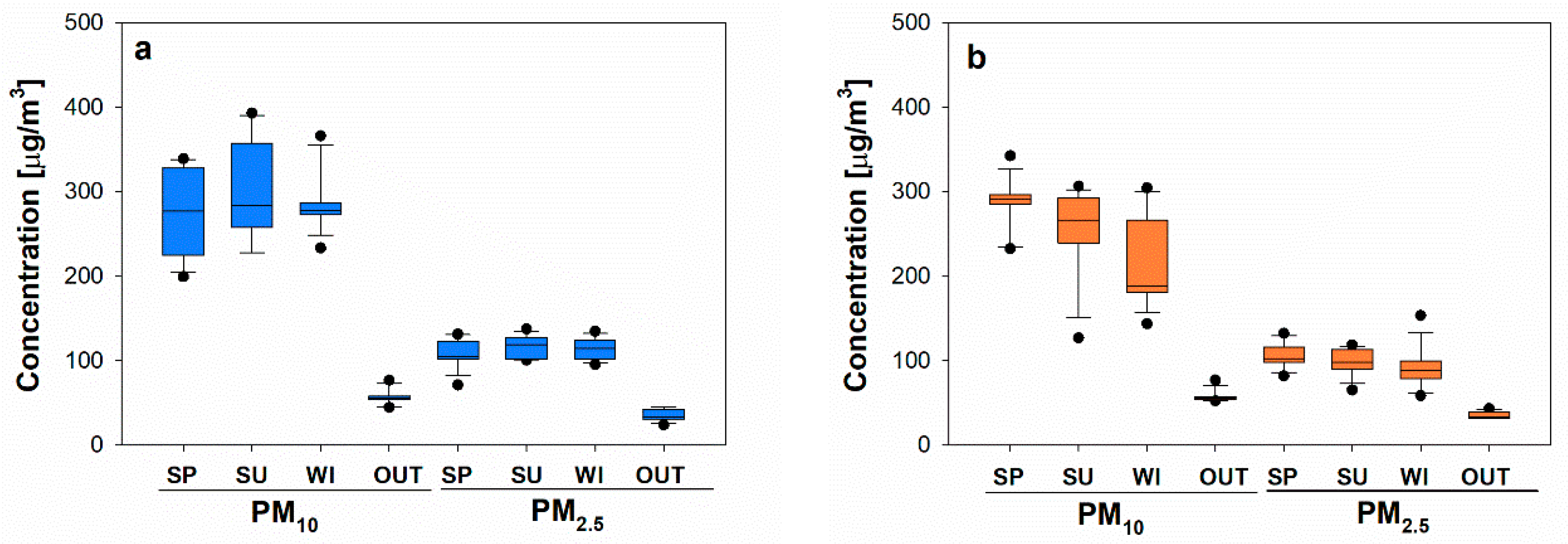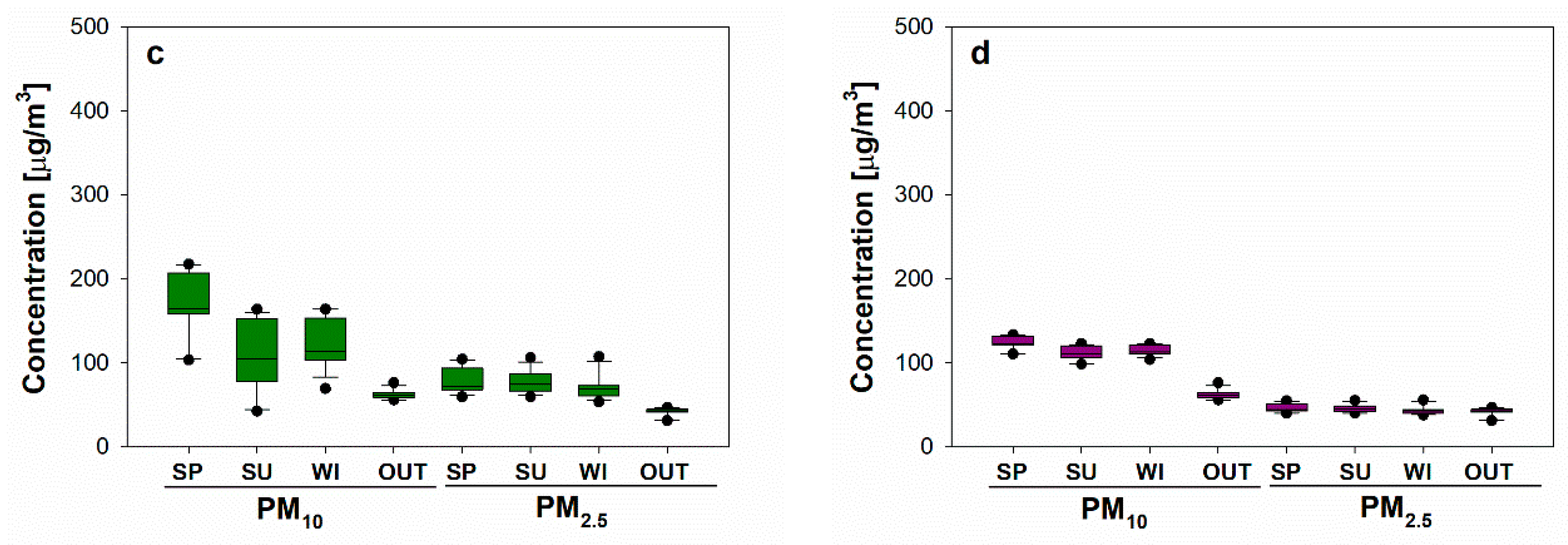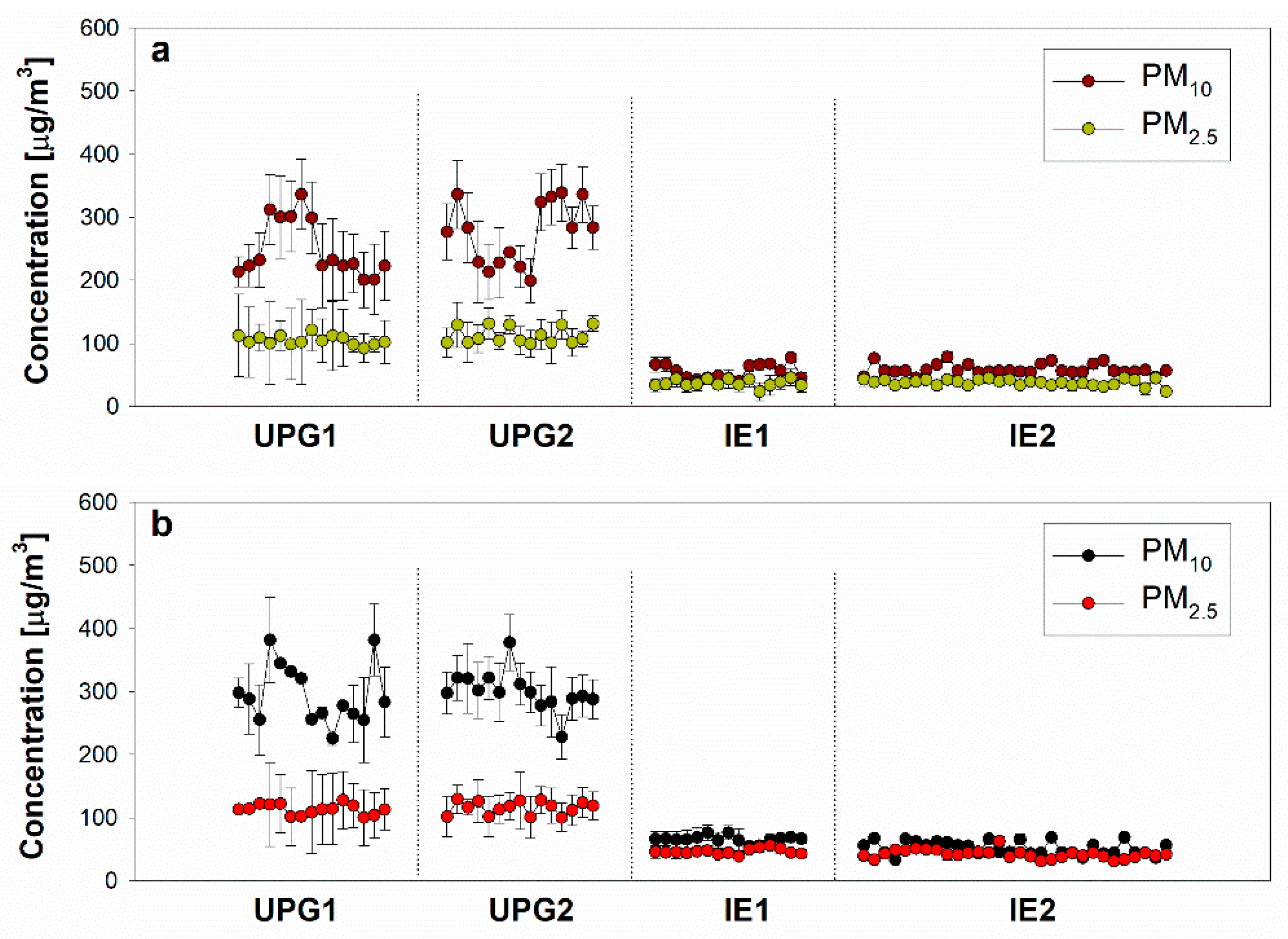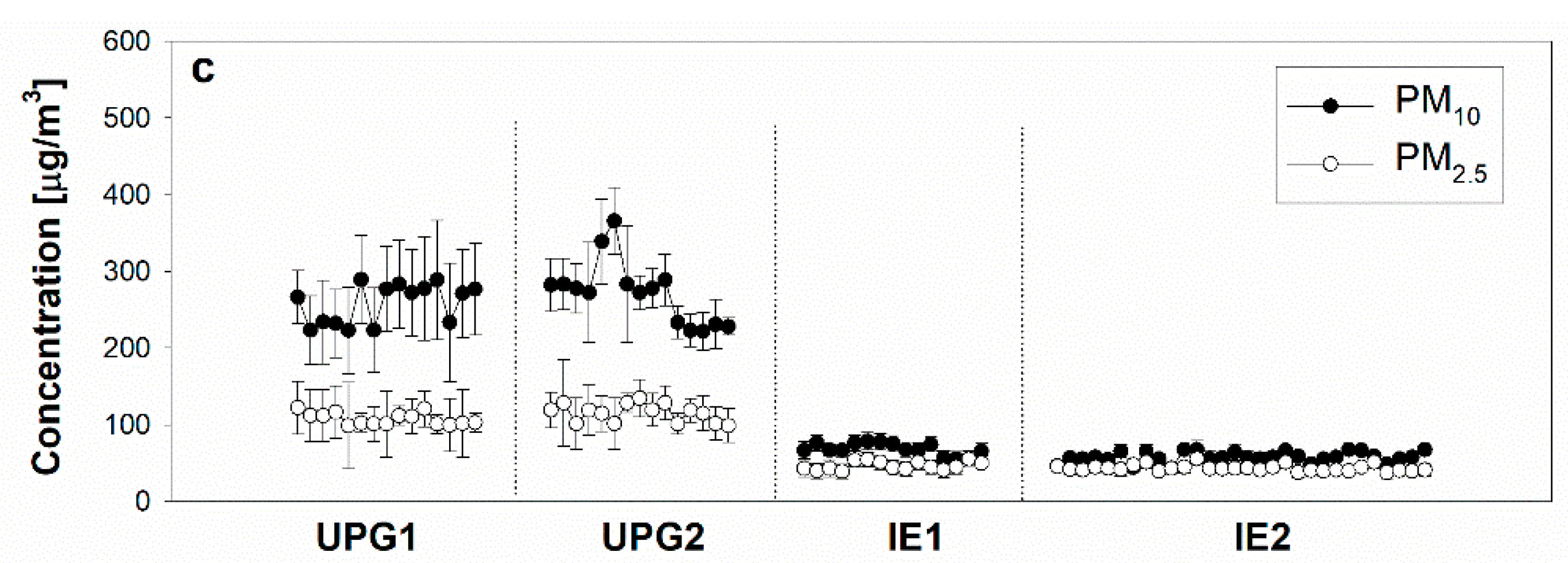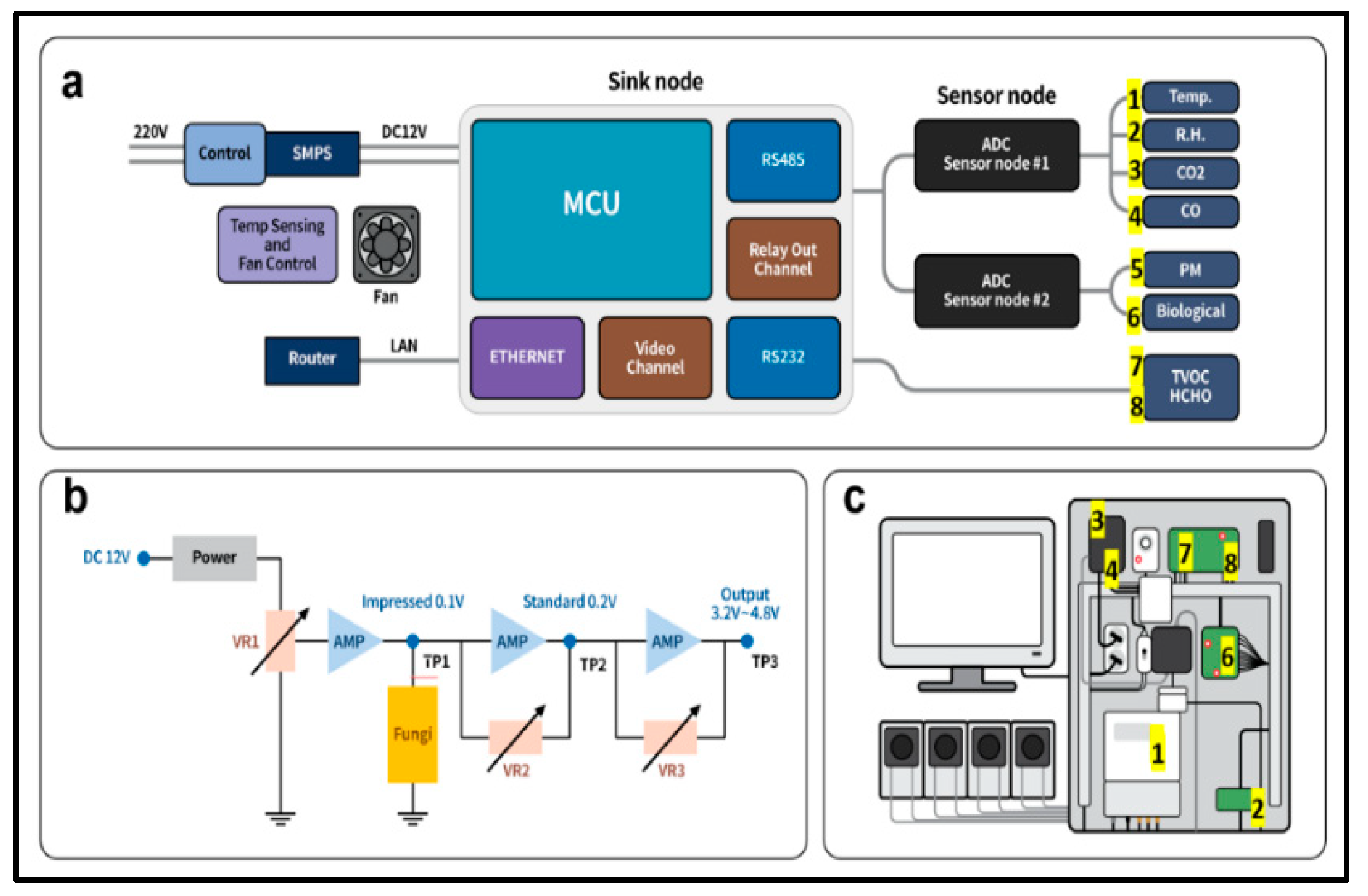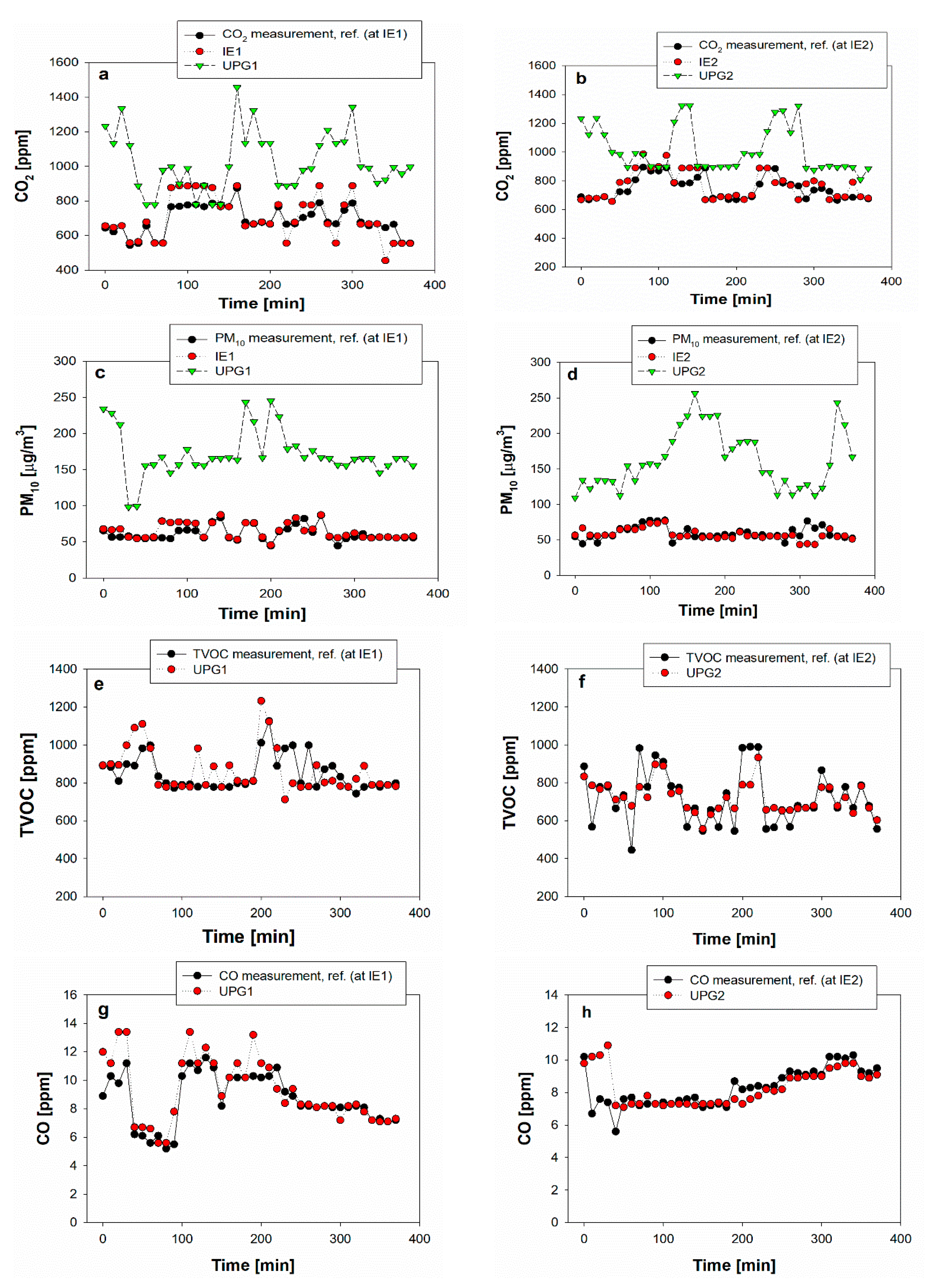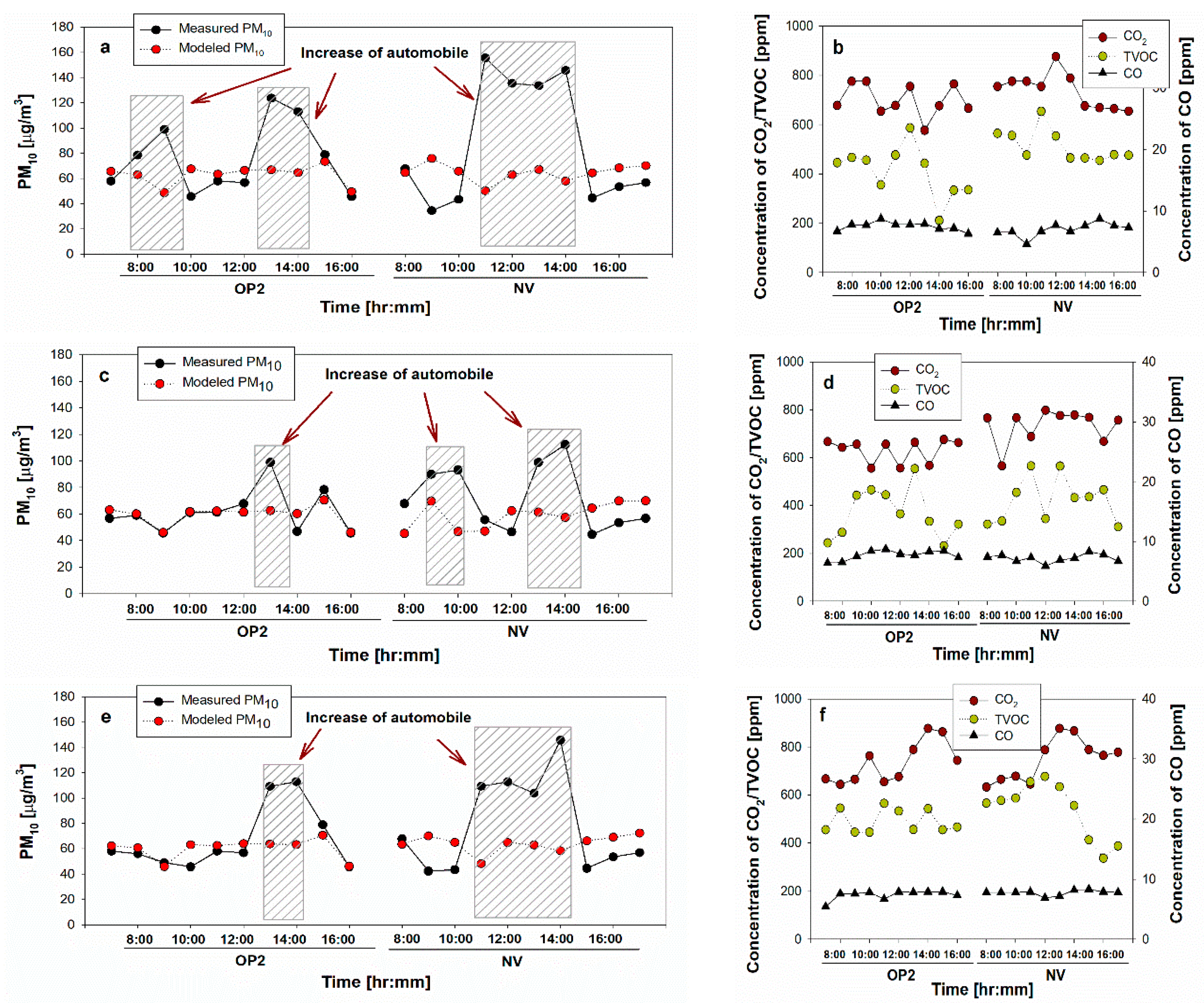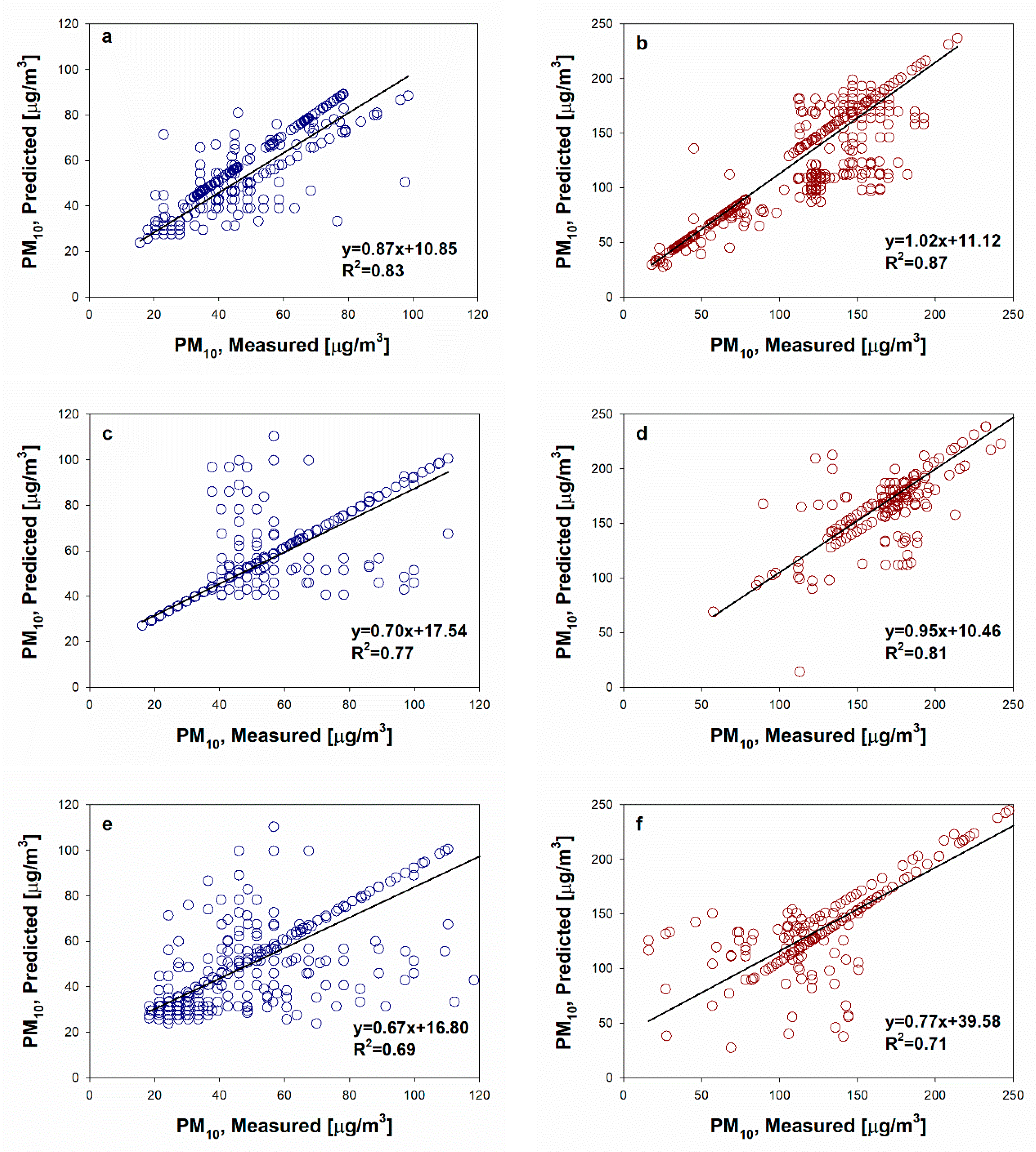1. Introduction
The development of underground parking garages (UPGs) has become widespread in cities due to the increasing number of automobiles [
1,
2,
3,
4,
5]. Nowadays, newly developed commercial and/or residential areas are mostly designed with UPGs equipped with ventilation systems (including natural ventilation); however, the air quality in UPGs has become an issue due to the impact of the volume of traffic on indoor air quality [
1,
2,
5,
6,
7]. Pollutants such as carbon monoxide (CO), carbon dioxide (CO
2), nitrogen dioxide (NO
2), particulate matter (PM), and volatile carbon (quantified as total volatile carbon; TVOC) are released from automobiles in these parking garages [
8,
9,
10,
11].
Indoor air quality is affected by a constantly changing interaction of indoor and outdoor factors. Pollutants generated from automobiles may accumulate in UPGs, and/or penetrate into the indoor environment [
1,
8,
12]. Particulate materials (PM
10, PM
2.5) within buildings are mostly derived from outdoor particles drawn in through HVAC systems [
1,
13,
14,
15,
16,
17,
18]. If the ventilation system is ineffective at completely discharging vehicle-induced pollutants from enclosed underground spaces, the pollutants can accumulate in these indoor environments and cause serious health effects in human beings [
2,
3,
6,
19,
20,
21,
22]. In urban environments, many commercial building designs have become larger due to commercialization and urbanization, and many strategies for the improvement of indoor air quality have been attempted to achieve energy conservation and reduction of the chimney effect. In the closed condition of a large building, outdoor pollutants generated by factors such as yellow dust and automobile soot can infiltrate the indoor environment.
There are few studies on how to cope with the symptoms of sick building syndrome and air pollution caused by microbial diffusion and reactions, such as severe acute respiratory syndrome (SARS) [
23,
24], and thus, an integrated indoor air quality management system using infiltration suppression technology based on an integrated sensor module is required for indoor building ventilation systems. To control the indoor air quality, integrated strategies should be considered [
25], including managing the sources of pollutants, diluting pollutants, removing indoor pollutants from the building through ventilation systems, and using filtration to rid the air of pollutants.
Even though underground parking garages are popular in many urbanized living environments, little is known about air quality monitoring in underground parking garages. The Intergovernmental Panel on Climate Change (IPCC) has presented artificial intelligence (AI), big data, and the Internet of Things (IoT) technologies as solutions to climate change [
26]. Currently, Korea is attempting weather forecasting using AI. In other words, the IoT can be used to secure accuracy and observation density in weather observation data, and digital technologies such as computer graphics can be used while collecting temperature, humidity, and wind velocity information.
Instead of indoor air quality measurement and analysis, mathematical predictive models can be a good alternative to providing reasonably accurate estimates. In this case, indoor air pollution modeling identifies the relative contributions of indoor and outdoor sources, weather, atmospheric concentration, deposition and other factors, which can contribute to indoor air quality monitoring [
27]. In addition, as predicted by extreme weather, concentration prediction models, after several hours, allow effective procedures in the area of indoor air quality monitoring [
28]. Moreover, artificial neural networks (ANN) are one of the preferred technologies in predictive models. Several studies on complex system prediction have proven that the performance of ANN is generally superior to traditional statistical methods and deterministic modeling systems, due to the limited need for computational efficiency, generalization ability, and prior knowledge of the modeling process structure [
29,
30,
31].
According to the World Health Organization (WHO), the global air pollution problem extends to the majority of the countries around the world [
32,
33]. To protect all indoor building occupants and maintain safe and healthy indoor environments, considerations for buildings should include occupant health, sustainability, energy efficiency, and the changing outdoor air quality [
34]. Controlling the indoor air quality is paramount for building the sustainable cities of the future. Some cities are using technology to reduce the harmful effects of polluted air as well as developing technology for smart city initiatives based on health vulnerability to air pollution. Since artificial neural network (ANN) significantly improve the accuracy of prediction, they have been frequently used as a non-linear tool in recent air quality forecasting [
35].
Past studies have shown that ANN can be applied to forecast air pollution whereas ANN has been used little to estimate air quality associated with the health effects [
36,
37,
38,
39]. Given the lack of data on personal exposure to respirable particles by penetration into buildings, a personal indoor exposure model with the calculated PM dosage and ANN model could be proposed to predict the pollutant concentration and evaluate the health effect.
This research has the following objectives: to (1) characterize concentrations of pollutants in UPGs and indoor environments; (2) evaluate the effect of the ventilation operating rates and the influence of the seasons; and (3) estimate the modeled personal exposure to PM associated with the health effects and predict the indoor PM concentration using artificial neural network.
3. Results
3.1. Analysis of Variations in the Measured Particulate Matter
To investigate the variations in PM concentrations (PM
10, PM
2.5) as a function of the effect of the ventilation in an HVAC system, the conditions of ventilation were determined as follows: NV for natural ventilation; 20% of air volume for OP1; 50% of air volume for OP2; 100% air volume for OP3 (
Figure 2).
The ventilation system mostly operated with a limited air volume (OP1: 20% and OP2: 50%), but maximum air volume (OP3: 100%) was applied in the morning and afternoon. Normally, it is operated differently for the underground parking garages’ HVAC systems. For the indoor environment, the HVAC system was operated regularly, once (for 1 h) in the morning and once (for 1 h) in the afternoon, every day, whereas the HVAC system in the underground parking garages operated continuously for 2 h at night due to heavy and/or accumulated pollutants.
Table 2 shows the concentrations of PM as a function of ventilation system during spring (SP), summer (SU) and winter (WI) seasons.
When the HVAC system was operated at an air volume of 100% in the underground parking garage, the concentrations for PM10 and PM2.5 achieved with natural ventilation (NV, 0% ventilation operation) were 199.5 μg/m3 (SP) to 386 μg/m3 (SU) and 71.1 μg/m3 (SP) to 137.4 μg/m3 (SU), respectively. When the different ventilations were applied, the PM10 concentrations were 127.0 μg/m3 (SU) to 342.5 μg/m3 (SP) for OP1, 69.5 μg/m3 (WI) to 217.5 μg/m3 (SP) for OP2, and 99.5 μg/m3 (SU) to 133.5 μg/m3 (SP) for OP3. For PM2.5, they were 65.2 μg/m3 (SU) to 153.4 μg/m3 (WI) for OP1, 59.4 μg/m3 (WI) to 107.4 μg/m3 (WI) for OP2, and 39.9 μg/m3 (SP) to 55.8 μg/m3 (WI) for OP3.
When NV (natural ventilation) was applied during the spring, summer and winter seasons, both PM10 and PM2.5 concentrations showed minimum values in spring and maximum concentrations in summer, while when the operation rates of the HVAC system were changed, the highest PM10 concentration was found in the spring season, and for PM2.5 the value measured during the winter season showed the highest value.
Table 3 shows pairwise comparisons of PM
10 concentrations by different seasons. There was a significant difference for PM
10 between SP and WI (
p < 0.001) for OP1 operation of the HVAC system, and when OP2 was applied there were significant differences for PM
10 between SP and SU/WI (
p < 0.001 for between SP and SU,
p = 0.004 for between SP and WI). For OP3, there were also significant differences for PM
10 between SP and SU (
p < 0.001) and between SU and WI (
p = 0.004). Meanwhile, there was only a significant difference for PM
2.5 between SP and WI with OP1 operation of the HVAC system (
p = 0.01).
As a function of the operation of the HVAC system, there were significant differences for the concentrations of PM10 between operations in the HVAC system during spring, summer and winter (except in the case of p = 0.174 between NV and OP1 for SP, and p = 0.878 between OP2 and OP3 for WI).
In Korea, natural ventilation is common. The results in
Figure 3 were obtained by measuring the PM concentration during natural ventilation, when the HVAC system was not operating. The concentration of PM
10 measured in the two underground parking garages (UPG1, UPG2) for the four seasons exceeded Korea’s regulation (indoors, for multi-use facilities: 100–200 μg/m
3).
During natural ventilation, the average four-hour indoor PM
10 and PM
2.5 concentrations for all investigated environments (UPG1, UPG2, IE1, IE2) during spring, summer and winter ranged from 199.5 to 382.0 μg/m
3 and from 92.3 to 131.4 μg/m
3; from 199.5 to 336.5 μg/m
3, from 255.6 to 322.0 μg/m
3, and from 222.0 to 283.5 μg/m
3 for PM
10 during spring, summer and winter, respectively; from 92.3 to 131.4 μg/m
3, from 100.3 to 126.9 μg/m
3, and from 98.9 to 128.7 μg/m
3 for PM
2.5 during spring, summer and winter, respectively. The average concentrations for PM (PM
10 and PM
2.5) are shown in
Table 4.
3.2. Air Quality Monitoring and Management
As shown in
Figure 4, the integrated sensor platform for real-time indoor air quality monitoring is a wireless sensor module that can independently detect the concentration of each pollutant and exhibits robustness against signal model issues and fluctuations of the signal patterns received from the analog digital converter (ADC) in the micro-controller unit. The wireless network also includes video channel sensor nodes, which are triggered upon detection of a fall, in order to analyze the field-of-view.
Based on the real-time integrated sensor platform (
Figure 4), real-time indoor air quality monitoring was conducted with natural ventilation for 400 min in two underground parking garages (UPG1 and UPG2) and two indoor environments (IE1 and IE2) (
Figure 5). For each indoor air quality factor (CO
2, PM
10, TVOC, CO), the concentrations measured in UPG1, UPG2, IE1, and IE2 were monitored in the computer of an integrated-sensor platform, and measurements using each measurement reference device were monitored in one of the indoor environment locations (
Figure S2): IE1 and IE2 for UPG1 and UPG2, respectively. As the results of indoor air quality monitoring with natural ventilation using an integrated sensor platform show, the CO
2 concentrations over 400 minutes ranged from 556 to 887 ppm (at IE1) and from 778 to 1456 ppm (at UPG1), from 667 to 987 ppm (at IE2), and from 807 to 1322 ppm (at UPG2). The PM
10 concentrations ranged from 53.4 to 87.4 μg/m
3 (at IE1), from 155.6 to 245.4 μg/m
3 (at UPG1), from 51.2 to 65.4 μg/m
3 (at IE2), and from 109.3 to 256.3 μg/m
3 (at UPG2).
For the management of air quality, the indoor air quality data were acquired with the integrated sensor unit and transmitted through the main server using the data transmission (S2) system (
Supplementary material Figure S3). The main server can consolidate the data related to indoor air quality and transmit all the data being monitored. In addition, the collected data transmitted to the monitoring control room are used to determine whether the factors influencing the air quality, measured through air quality prediction (S3) (
Supplementary material Figure S3), fall within the normal regulated and/or controlled range. The integrated module system uses an automatic algorithm to judge a measurement whether the HVAC system is available based on the outdoor air quality. If the values are out of the normal/regulated range, the readout is considered abnormal, and it is judged in real time whether the indoor air quality is normal by judging individual air quality influencing factors. Further, air quality prediction (S3) is performed to determine the inflow path for the factors influencing the air quality that are determined to be abnormal (S4) (
Supplementary material Figure S3). Penetration estimation (S4) can be used to divide the air quality factors into particles and gases in the monitoring control room and examine the sources of the factors influencing the air quality, such as particles and gas. Further, penetration inhibition (S5) is a step for suppressing penetration of the factors influencing the air quality through the inflow path identified by penetration estimation (S4) (
Supplementary material Figure S3). Each data point collected for the sensor module was linked to the Zigbee and should be linked to the (Machine to Machine) Gateway. The linked data can be collected by a gathering server based on HTTP and JSON standards. However, many sensors were installed at various measurement points for the indoor air quality measuring device (including the sensor), as the indoor and outdoor pollutant inflows are mainly caused by infiltration from the air handling unit (AHU), building interior, and elevator (escalator) in most closed buildings. Thus, sometimes, the data were obtained from a router and monitoring server in the middle of each floor, a suddenly broken corridor, and spaces at which disturbance is suspected.
Both TVOC and CO concentrations were monitored in the two underground parking garages (UPG1 and UPG2), and the concentrations of TVOC ranged from 778.3 to 1232.3 ppm and from 556.7 to 897.3 ppm in UPG1 and UPG2, respectively. The CO concentrations ranged from 5.6 to 13.2 ppm and from 7.2 to 10.9 ppm in UPG1 and UPG2, respectively. The concentrations for CO
2, PM
10, TVOC, and CO obtained from the integrated sensor platform fit well in the comparison of each measurement reference device (
Figure 5).
Table 5 shows the average concentrations for CO
2, PM
10, TVOC and CO investigated in UPG1, IPG2 and IE1 and IE2.
3.3. Modeled Personal Exposures in an Indoor Office and Underground Parking Garage
As shown in
Figure 6, the indoor PM
10 concentrations measured using the integrated sensor platform were compared to the modeled values using Equation (1). The personal PM
10 exposure was estimated by using indoor and outdoor PM
10 concentrations, separately. The indoor PM
10 concentrations were modeled using the parameters for indoor environments taken from the literature with the measured outdoor PM
10 concentrations: 1.2/h for α, 0.39/h for D, 1 for P, 0.001 μg/m
3, calculated E2 based on PM
10 concentrations in UPG1, 45 m
3 for V.
The resulting measured exposure (for 8 h) of the 60 collected profiles (data obtained by monitoring 60 times) for (PM
10, TVOC and CO) by the integrated sensor platform ranged from 34.5 to 155.6 μg/m
3 (300–400 cars/day), from 33.4 to 112.3 μg/m
3 (200–350 cars/day), and from 42.3 to 163.2 μg/m
3 (250–400 cars/day), whereas the modeled exposure calculated by Equation (1) ranged from 42.3 to 73.5 μg/m
3 (300–400 cars/day), from 36.7 to 70.6 μg/m
3 (200–350 cars/day), and from 39.33 to 70.6 μg/m
3 (250–400 cars/day) (
Figure 5). Concentrations higher than the modeled concentrations showed a high variability over the day due to the penetrations of PM
10 concentrations from UPG1. Due to the large contributions of the particle sources released from UPG1, exposure to the higher PM
10 concentration of UPG1 was in most cases in a small office where an employee works all day long. The PM
10 concentrations determined in IE1 were well approximated, except for the peak of PM
10 due to an increase in the number of cars in UPG1.
These results show that an indoor environment is influenced by the PM10 concentrations released in UPG1. Actually, an increase in the number of cars in UPG1 meant an increase of PM10 concentrations and resulted in higher PM10 concentrations by pollutant penetration from UPG1.
With the PM
10 concentrations, the concentrations of CO
2, TVOC, and CO in an indoor environment (IE1) were investigated by the real-time indoor air quality monitoring system, and for HVAC ventilation, the OP2 operation was preferred based on the results of the reduction efficiency of PM
10 (
Figure 2).
Figure 6 compares pollutant concentrations for PM
10, CO
2, TVOC, and CO between OP2 operation and natural ventilation. During OP2 operation in ventilation, the concentrations of CO
2 were 577–776 ppm (300–400 cars/day), 557–676 ppm (200–350 cars/day), and 644–877 ppm (250–400 cars/day); the concentrations of TVOC were 211–587 ppm (300–400 cars/day), 232–466 ppm (200–350 cars/day), and 445–565 ppm (250–400 cars/day); the concentrations of CO were 6.3–8.7 ppm (300–400 cars/day), 6.4–8.7 (200–350 cars/day), and 5.4–7.9 ppm (250–400 cars/day). During natural ventilation, the concentrations of CO
2 were 566–877 ppm, the concentrations of TVOC were 311–677 ppm, and the concentrations of CO were 4.6–8.7 ppm, in all investigated data (
Figure 6b,d,f).
3.4. PM Dosage in Respiratory System
PM doses were calculated in indoors (IE) and UPGs (UPG) for PM
10 and PM
2.5 (
Figure 7). For PM
10, DF was calculated as the fraction of inhaled particles that deposit in the entire respiratory system: the head airways (HA), tracheobronchial region (TB), and the alveolar region (AL) and PM
2.5. DF was calculated only as the PM deposited in the alveolar region (AL) [
50].
For all investigated locations, 85–92% of PM deposition occurred in the entire respiratory regions while 7.0–8.5% of PM deposited in the alveolar region.
To evaluate the health effects associated with PM (inhalable and respirable PM), we have applied a model recommended by ICRP 66, which uses the dosage for PM
10 and PM
2.5 by considering the auto vehicle volume and season. Dosage is a common metric used for exposure assessment for predicting the health effects [
51,
52]. In this study, the inhalable dosage (based on PM
10) and respirable dosage (based on PM
2.5) were calculated using the number concentrations of PM obtained by Grimm 1.109 OPC.
As shown in
Figure 7, during spring, summer and winter seasons, the calculated dosage ranged from ~×10
4–~×10
5 μg (except for PM
2.5 for winter, ~×10
3). There are significant differences for PM
10 and PM
2.5 between IE and UPG (
p < 0.001). However, there is no significant difference for season and auto vehicle volume.
3.5. Prediction of Indoor PM Concentration Using an ANN
Based on the input variables and algorithms mentioned above, indoor air quality prediction modeling of indoor environments and underground parking garages was performed as a function of the season (spring, summer, winter) (
Figure S4), and the correlation between measured and predicted values is shown in
Figure 8: 0.83 (IE2, the second floor indoors) and 0.87 (the underground parking garage) for spring; 0.79 (IE2, the second floor indoors) and 0.81 (the underground parking garage) for summer; 0.69 (the second floor indoors) and 0.71 (the underground parking garage) for winter. The difference between the predicted value and the measured value depended on the season, outdoor pollution level, weather, and the vehicle traffic/frequency, with different characteristics.
During the winter, it was analyzed that the correlation with the predicted PM was lower (R2 = 0.69 and 0.71) compared to the other seasons, due to the decrease of automobile volume/frequency and the change of outdoor temperature (not shown in this study), but it showed a very high correlation (R2 = 0.83 and 0.87) during the yellow dust period in spring or when the outdoor air quality deteriorated, and there were many cars entering the underground parking garage. This can be applied to a prediction program for operating the underground parking ventilation system, and if more diverse input variables and improved algorithms are applied, the accuracy of the actual fine dust prediction results will be improved.
Feedforward backpropagation (FFBP) was evaluated using the minimum root mean (RMSE), maximum prediction accuracy (PA), normalized absolute error (NAE), and index of agreement (IA). The calculated parameters for PM ranged from 0.15 to 0.19 for RMSE, 0.83 to 0.92 for PA, 0.17 to 0.19 for NAE, and 0.88 to 0.92 for IA.
4. Discussion
This study conducted indoor air quality monitoring (
Figure 3 and
Figure 5) based on an integrated sensor and conducted an exposure assessment (
Figure 6) based on a personal model of human exposure for evaluating human health effects in an indoor environment, rather than a simple monitoring and measurement study. For indoor air quality management while considering the operation of an HVAC system and outdoor air quality, it was possible to conduct indoor air quality monitoring and predictive research using an ANN model.
Due to energy issues, most underground parking garages use natural ventilation systems or separate ventilation units [
3]. However, the high cost of separate ventilation systems results in relatively sparse monitoring, which provides accurate data but only in a few locations. Moreover, most air quality monitoring is conducted using static monitoring stations equipped with certificates; thus, it is difficult to control the pollutants released in UPGs and estimate the potential health burden.
By considering factors such as the ventilation rates in HVAC systems, this study established real-time monitoring based on an integrated sensor platform for evaluating personal exposure to pollutants, and could estimate indoor PM concentrations using an ANN by considering the outdoor air quality, weather, automobile frequency, and other factors.
As shown in
Figure 3, the concentration of PM in the underground parking garage showed a concentration (max: 336 μg/m
3) significantly exceeding the Korean standard value (100–200 μg/m
3). It can be seen from
Figure 6 that the high concentration of PM
10 affects the indoor PM
10 concentration of the indoor first floor office adjacent to the underground parking garage, so pollutants in the underground parking garage enter/penetrate indoor environments through various pathways, such as the entrance doors and elevators in the building, resulting in adverse of health effects. The comparison of the PM concentrations of the underground parking garage and the indoor office shows that the air quality in both the indoor spaces and underground parking garage could be improved by using the correct HVAC operation (
Figure 2). However, if the outdoor air quality deteriorates, it cannot be guaranteed that the operation of the air conditioning system, due to the inflow of external air as well as natural ventilation, could improve the indoor air quality. The outdoor air quality may still deteriorate, and in this case, the operation of the HVAC system must be customized according to the outdoor air quality and, in particular, the air quality management of the underground parking garage.
Prior studies have evaluated the concentrations of VOC in parking garages, demonstrating a strong dependence on automobile sources and the activities of building occupants, even though the VOC concentration does not tend to be significantly correlated with the garage atmosphere [
8,
13]. Compared to the measured indoor monitoring data, the modeled data of the profiles in
Figure 5 show mostly higher personal exposure to PM
10, which is similar to the conclusions of the penetrations of PM
10 from vehicle-induced sources. Considering the traffic volume in parking garages, the air quality must be controlled due to penetration into indoor environments with occupants. High volumes of automobiles lead to an increase in PM
10 concentrations, and more importantly, the PM
10 concentrations can be changed and/or decreased due to use of an HVAC ventilation system. This real-time air quality monitoring system could lead to the evaluation of the indoor air quality in UPGs associated with personal-exposure vehicle-induced pollutants, based on an integrated sensor platform which uses an M2M wireless sensor network, and we also showed the potential for indoor air quality prediction using an ANN (based on the calculated 0.69–0.87 for R
2 between the measured data and predicted data), based on the variable data such as outdoor PM concentrations, weather, the frequency of automobiles in parking garage, and the developed learning algorithm.
This study is from five years ago and building design (including parking garage) and pollutant emissions from vehicles today could be different. However, an algorithm applied to this study could input different pollutant concentrations in various indoor environments and be further expanded to allow altering the algorithms that differ in weather conditions, outdoor pollutants, and input parameters such as vehicle type, vehicle fuel, and vehicle driving time based on the traffic volume. This study was an attempt to expand the monitoring system, predict pollutants, and evaluate health effects by considering the application of various factors in these algorithms applying an ANN. Although this study involved measurement and monitoring five years ago, the monitoring techniques and health impact assessment based on personal exposure to pollutants presented in this study are useful for future building design and indoor air quality monitoring. As in past studies, the ANN model provided better results than other models, especially ANN models written with non-uniform variance. Thus, the ANN model with the proposed monitoring technique and personal exposure evaluation applied the current ANN. We consider our study as more important for air quality monitoring and will be effectively applicable to all kinds of monitoring and air quality prediction, including of various other components.
Due to the increase in the exhaust emission concentrations in closed areas with insufficient ventilation, commercial underground parking garages in the city are becoming an important issue. The 2013 parking regulation in Korea has determined as 100 m2 is required per car and underground parking spaces in commercial buildings are recommended to have more spaces than the legally required number of parking spaces. Since the number of automobiles has continuously increase, various car-induced pollutants including PM accumulate in underground parking lots. Especially as underground parking lots rely on natural ventilation in a trapped structure, their pollution degree is more serious due to the low driving speed and idling the cars in these garages. In the underground parking lot regulations, the operation of the air conditioning system and the setting of the ventilation rate are calculated based on indoor and outdoor CO concentration and vehicle idling times. However, for PM, which is one of the pollutants sourced from automobile emissions, the simple concentration rule is applied only to PM10 concentration, even though it has been the subject of continuous short- and long-term pollutant exposure management.
In this study, we evaluated respirable PM and TVOC concentrations and health effects in underground parking lots, and the PM2.5 concentration was more than five times the standard value due to continuous vehicle inflow during the night without the ventilation system running. Currently, there is no regulation for PM2.5 concentration in underground parking garages, so the seriousness of automobile emissions is neglected. Vehicle-induced pollutants are accumulated indoors for a long time, and the resuspension of pollutants due to driving the vehicle results in long-term exposure to the pollutants. Although efforts have been made to improve indoor air quality, such as the operation of an air conditioning system indoors, automobile-emitted carcinogens in underground parking garages could be moved to the indoor office environment along with other pollutants through the inflow path in the building. This has the potential to be detrimental to human health, posing a challenge for designing a sustainable future. More importantly, the lack of data about the quantitative exposure to pollutants based on monitoring and health effects is one of the reasons why the development of regulations for pollutants has been delayed.
The real-time monitored PM used in our study was modeled based on the average daily PM concentration. However, in our future research, we will receive weather data in real time, connect our modeling algorithm program to predict the change, and prepare hourly concentration and prediction programs based on this. In this case, a long-term prediction model will be possible. We will attempt to adapt the algorithm to predict short-term changes such as extreme weather conditions.
To estimate PM concentration associated with health effects, we considered daily input data from 2014 to 2015 for: traffic volume, indoor and outdoor PM concentration, and season. Firstly, we aimed to predict PM concentrations due to temperature and weather events, but we found no relationship of exposure to PM in indoor environments with outdoor temperature. Therefore, we determined that the exposure to PM related to health effects is dependent on season. More monitoring and evaluation may be required for the prediction of PM due to the variation of temperature, weather conditions, and short-term pollutant events. In the future study, we will provide a modified algorithm utilizing conditions used in this study as well as weather conditions in the ANN model. The future study along with current study results will bridge the gap between exposure to pollutants and evaluation of health effects, providing the technology required toward an environmentally sustainable community.
What we need to keep in mind is that simple indoor air quality monitoring cannot contribute to human health risk assessment and indoor air quality improvement, and in order to improve indoor air quality based on monitoring, pollutant exposure evaluations based on health impact assessments must be conducted. Considering these points, this study applied exposure modeling, considering indoor pollutants and outdoor exposure factors, to enable health impact assessment. If applied together with the ANN model, it is possible to predict future indoor air quality, as well as to evaluate health effects. During the development and comparison of the personal exposure model and ANN model, this study focused only on PM10 concentration. For PM concentration, it is necessary to monitor the concentration of PM2.5, because PM2.5 further affects health. Since the regulation standard for underground parking garages in Korea is defined by the PM10 concentration, this study monitored the PM10 concentration and compared the modeling results. In the future, the monitoring of PM2.5 concentrations, along with other pollutants, will require similar predictions.
